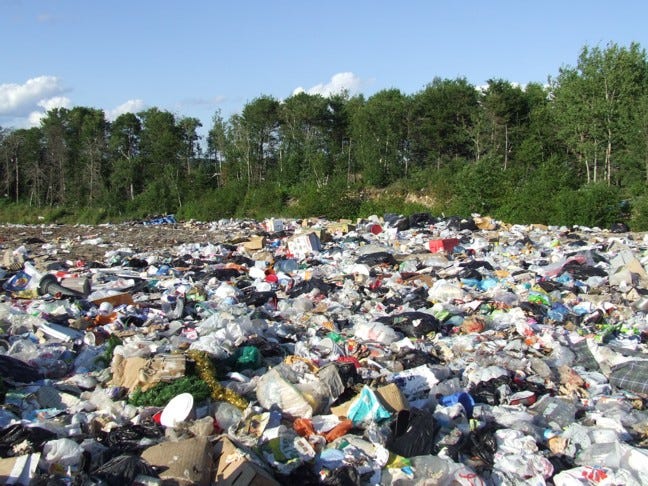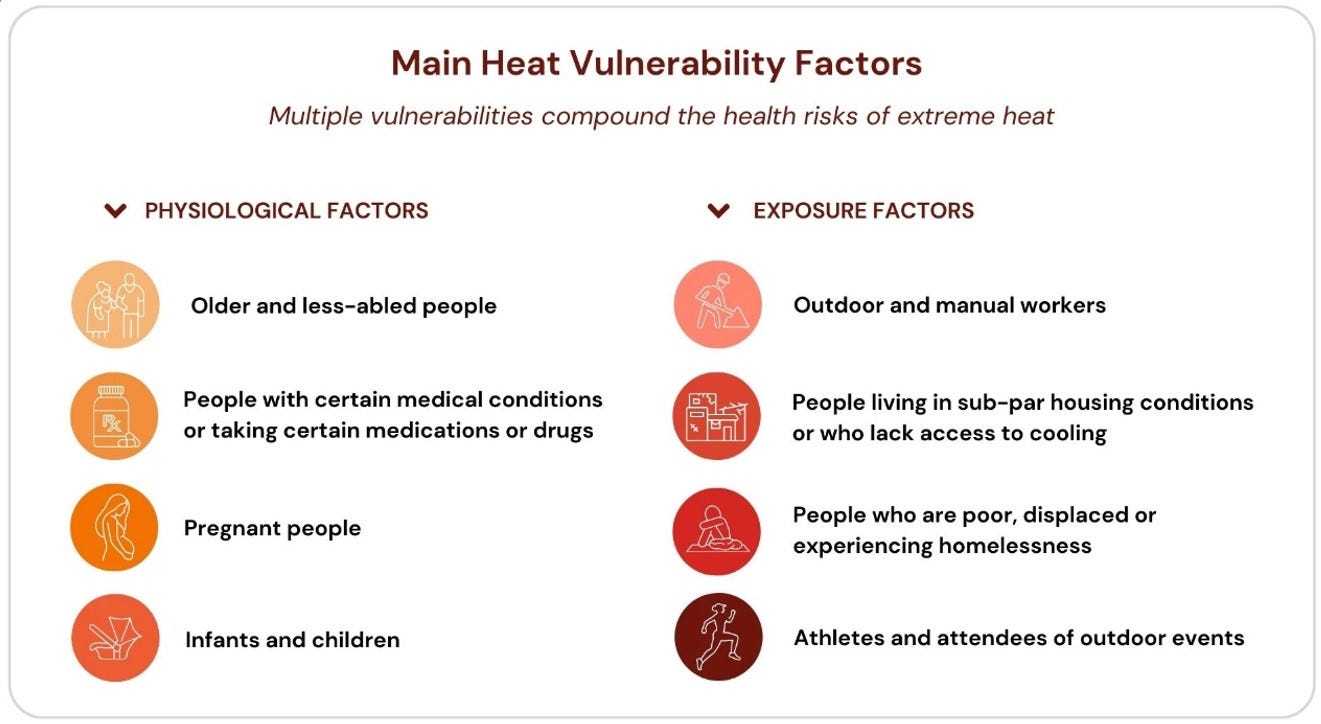1 Week, 7 Stories #31
Crabs on cocaine, kids’ brains on smartphones, extreme heat on your body, workers at risk, and our mountain of garbage.
Every edition features 7 stories, from the past week. I’ll draw on my background in media, journalism, agriculture, biotech, and renewable energy to come up with an interesting selection and to offer some context.
Depending on which source you consult either Will Rogers or Mark Twain said. “Buy land, they’re not making it anymore”. Apparently, they both made the quote famous though Twain was the first to use it.
We’ll start off this week’s newsletter looking at agricultural research and innovation aimed at making the most of a very precious commodity. Land.
When I was working with Alberta Beef Producers, precision agriculture was more potential than it was reality. A few years later while working in the biotech sector, precision agriculture was gaining traction, and today? A Canadian Press story says that AI has entered the precision agriculture picture. We’ve come a long way.
Precision agriculture brings data onto the farm. Lots of data. Irrigation numbers, fertilizer use, GPS data to track yields, soil sensors, satellite guided tractors, drone surveys, food intake by livestock, and just about any other data that in years gone by was written in notebooks, if it was tracked at all. Acting on this new data is working for operations such as Nature Fresh Farms noted in the CP story, but smaller operations are struggling to makes sense of all the data. Which is where artificial intelligence can help.
A recent article in Agricultural Science & Technology (sorry, only the abstract seems to be available) points out that AI can analyze data for small-scale farming operations to predict immediate on-farm needs and market conditions for planning future operations. A peer-reviewed paper in the forthcoming issue of Smart Agricultural Technology (this one with full access) found that crop yields can be improved by 15 to 20% and overall investment reduced up to 30% by using machine assisted technology for precise planting, spraying, weeding, and crop monitoring using ATVs to gather data, often autonomously.
To produce enough food to sustain the global population growth expected by 2050, farm efficiency must increase significantly. These new Smart Farms are key to ensuring that efficiency as we enter a new era in agriculture.
As Calgary continues to struggle with a massive water main break, I have been using paper plates and bowls to limit how many dishes there are to do. Which means now figuring out the best way to dispose of those disposable dishes. According to the City of Calgary ‘What goes where’ a ‘Plate-paper/party’ goes in for composting but ‘Plastic cutlery’ goes into the black garbage cart. Too small to be sorted properly it says. Checking other municipalities’ suggested options for ‘Plate-paper/party’ the answers range from recycling to garbage to composting.
Which begs the question of just how efficient and consistent we are when it comes to disposing of waste. According to Statistics Canada, as of June 6th, the amount of solid waste we churned out in 2020 was 36 million tonnes, up from 5.3 million tonnes in 2002. While the numbers are improving, we only managed to divert 9.9 million tonnes in 2020. Sadly, we produce about 694kg (1530 lbs) of garbage per person every year which puts us in the top wastrels in the world, though we do better in recycling than many developed countries. Within Canada, Ontario and Manitoba are the only 2 provinces that do not have a deposit and return system or non-alcoholic drinks containers so not surprisingly 1.7 billion plastic beverage containers end up as garbage in Ontario.
A New York Times story this week outlined some of the problems faced when we try to keep our garbage out of the landfill. For instance, when it comes to plastics there are many different types of plastic – some recyclable, some not – and it is labour-intensive to sort out one from the other. Like that plastic cutlery. If it gets too complicated and therefore expensive, a whole load simply gets diverted to the landfill.
The World Bank estimates that the world generates 2.01 billion tonnes of waste every year and that number is headed up. That breaks down to roughly 3,825 tons of municipal waste produced and collected every minute.
About the time it took for you to read this part of 1 Week, 7 Stories.
Work was temporarily halted last week on the Calgary water main break repairs after an accident injured two workers at the site. Both are recovering. This week a construction worker in Montreal was killed when he was struck by a falling object, another worker died in an accident at a Kelowna construction project, and a fall in Canmore killed a worker at a residential worksite.
In Canada between 900 and 1,000 workers die every year due to work-related causes, and the Canadian Occupational Safety website says the number could be considerably higher. Numbers for workplace and work-related injuries and deaths are difficult to compile because data comes largely from provincial worker compensation boards which only track compensation claims. Illness, lost time, or death may also be incomplete because the direct link to the workplace is not always apparent. An annual report prepared by University of Regina researchers seems to contain the most reliable numbers because it compiles data from a number of sources, but even it does not keep up with the most current data.
The other challenge in compiling workplace related injuries are those related to psychological or stress related issues. Statistics Canada undertook a survey in April of 2023 and found 7.5% of employed Canadians (approximately 1.2 million) took time off work because of work-related stress or for mental health reasons in the 12 months leading up to the survey.
The increase of on-site deaths and injuries could be attributed to post-pandemic pressure to finish construction projects quickly and a shortage of skilled workers leading to long hours and overtime according to the Christian Labour Association of Canada. Respondents to the Stats Canada psychological and mental health survey reported a range of factors including work-life balance, heavy workloads, harassment, and lack of support from management.
Whatever the reasons, it appears workplace related illnesses, injuries, and deaths are increasing, and some action is necessary, perhaps starting with improved data collection and reporting coupled with detailed analysis of the information.
Motorola released its DynaTac cell phone in 1984 and arguably only a few people had one on that first day. Today there are 7.2 billion mobile phones in the world. In Canada 87% of children between 12 and 17 years of age own one. Nearly a quarter a quarter of children five-to-seven-years-old in the UK now have their own smartphone. There are a lot of kids using a lot of smartphones around the world and chances are all those kids are using their smartphone in school.
This week the Government of Alberta has said, ‘hold on’, because starting in the next school year that will change.
The media release says the decision was based on a province wide survey of “parents and stakeholders”, and to set a consistent standard across the province. The individual school authorities will develop their own policies for managing the standards, setting parameters for exceptions, and establishing consequences for students who still try to sneak-a-peek during class.
Apart from an attempt to limit distractions in class, Alberta’s Education Minister also cited “The risks to student mental well-being” as a concern. The same risks that the U.S. Surgeon-General warned about this week. He went so far as to say that social media apps should come with a warning label. Not that your average student would ever pay attention to such a warning, but it would help raise awareness and perhaps lead to parents imposing some guidelines for their children.
Alberta is certainly not alone in the trying to limit the use of cellphones by young people. Nova Scotia made the move in the first week of June and when Quebec students returned to classes in January they too had to put their devices out of sight. Ontario introduced limits in 2019 but has been so lax in enforcing the ban they decided to take another crack at the guidelines in April. New Brunswick has set limits, Nova Scotia allows teachers to make the decision in their classrooms but that seems about to change as well. BC has been dithering but it looks like back to the books and away from the cellphone in September. Beyond those bans it seems that other provinces address it as part of broader technology use guidelines or leave it to school districts and teachers.
As Sara Hamilton an assistant professor at Mount Royal University noted in a CBC Radio interview this puts more pressure on teachers to enforce the policy in already busy classrooms with greater pupil to teacher rations. In Ontario it has led to complaints from teaching unions before the ban is even fully in place which the led a National Post columnist to suggest if teachers can’t handle the ban maybe “they should be in another line of work”. One teacher in Arizona did exactly that. The teacher profiled in this story from The Wall Street Journal felt he was seeing kids checked out and, in his view, addicted, which robbed him of the joy of teaching. It is an interesting piece and the link should be free.
Maybe if we simply went back to those big old Motorola shoe phones students would never want to pull them out during class. Or anywhere else for that matter.
It is getting hot outside. Really hot in some parts of North America this week as a heat dome settles into place with temperatures in the US Midwest passing the 37.8 degrees Celsius (100 degrees Fahrenheit) mark. In Canada, “dangerously hot temperatures”, have triggered heat warnings in Ontario and Quebec and parts of Atlantic Canada.
The human body is not built for such extremes.
For a start it “has significant impacts on mortality” according to a new report posted this week by the Health Analysis Division at Statistics Canada.
Ideally, our body functions efficiently at a core temperature of 37 C (98.6 F). Consider it your thermal sweet spot. Your skin temperature is slightly lower and when the air temperature exceeds your skin temperature sweating loses its cooling effect and it gets even worse when the humidity is high as well. As temperatures rise your brain calls down to your heart and says increase your heart rate and dilate the blood vessels to move blood faster to the surface of your body to cool it down. As the outside temperature continues to climb the cooling effect of that bodily response has a limited effect. Sweating still continues which starts to lose salt from your body and dehydration becomes a risk. Once your body temperature starts to move past 40 C (104 F) it simply starts to shut down.
Heat is sometimes called the silent killer because the symptoms are not always evident and in extreme heat waves the elderly, those with pre-existing conditions that make them more susceptible, and the poor without access to air conditioning or public cooling facilities, die at home.
Climate changes is leading to more prolonged heat waves, more heat stress, and higher mortality related to heat.
The first official day of summer was on the 20th so brace yourself and keep these tips on how to cool your body down fast in mind during the hot weather ahead.
While it may seem somewhat amusing to imagine a mellow fish lazing away in a stream because it has taken its anti-anxiety meds, it is anything but amusing.
In an interview this week on The Current, Karen Kidd, the Jarislowky Chair in Environment and Health at McMaster University, said fish are exposed to a “soup of drugs” in their habitat.
Ms. Kidd was one of the authors of an article published this month in Nature Sustainability which said we need to develop ‘greener’ drugs, improve wastewater treatment to filter out harmful drugs, and raise public awareness on the proper disposal of drugs. The article cited a study published in Environmental Toxicology and Chemistry, which found that river water taken from 1,052 locations across 104 countries, had levels of at least one drug exceeding what is considered safe for ecological health in 43% of the sampled sites.
The effects of these various pharmaceuticals can vary, but in the case of fish exposed to anti-anxiety meds, they get bolder and don’t rely on their usual survival skills. Even though we have known for some time that contraceptives that end up in the water can cause sex reversal in fish, the problem persists.
It is not just prescription drugs that are the problem. In the United Kingdom, crabs and shrimp are getting high on cocaine, amphetamines and MDMA.
We are stressing our environment with climate change, habitat loss, and overfishing – we don’t need to add drug overdose to the list.
We are in the perfect time of year to think about having some fresh cherries, but archaeologists on a dig on the banks of the Potomac River had to settle for 250-year-old cherries. The dig was at the Mount Vernon home of George Washington and the cherries were found in bottles of preserved fruit in the cellar of the old mansion. There were also bottles of preserved currants and gooseberries.
When done right, food can last for a remarkably long time, though not everyone might be willing to taste it.
In some cases, experts even advise against taking a bite like the 2,000 year-old bog butter found in Ireland in 2016. It is called bog butter because it was often buried in peats bogs to preserve it or as an offering to the spirits and is definitely not compatible with your morning toast.
Wine improves with age, but there is a limit, so no one is prepared to open the Speyer Wine bottle found in a Roman tomb in Germany in 1867. It dates to between 325 and 359 AD and until this week was the oldest unopened wine bottle. It may still be considered for the title of unopened bottle because the new find actually is a glass urn found in a tomb dating back to the first century AD. It was discovered in 2019 but until the University of Cordoba confirmed it was wine it was not official. However, you definitely would not want to sample this one as the urn also contained human remains. The oldest wine barrel with wine still in it is in the cellars of the University Hospitals of Strasbourg in France and was made in 1472. It has been tasted a few times and is said to be a “typical light white wine”.
In Bangkok a pot of soup has been simmering for about 50 years. Sort of. The restaurant got the pot boiling 50 years ago but regularly empties it for cleaning and then uses a portion of the soup as stock to start again.
When stored properly, yeast can have a remarkable shelf life. Tech entrepreneur Seamus Blackley who created and designed the first Xbox, used 4,500 year old yeast to make a sourdough starter and has made – and eaten – the resulting sourdough bread. That was in 2019 and he is still using that starter. The Boudin Bakery in San Francisco claims to be using the same sourdough starter it opened with in 1849. True or not it does make a great claim to fame.
A 2020 story in The Guardian has some great pictures of a well-preserved “snack bar” in Pompeii which still had the remains of pigs, goats, fish, and snails in earthenware pots. And while they have yet to find a preserved pizza in Pompeii this story from The Washington Post (a free link) shows the image of what certainly seems to be a pizza as part of a fresco on the wall of a home in Pompeii connected to a bakery.
The oldest known fruitcake (which we generally consider Christmas cake here in Canada) belongs to a family in Tecumseh, Michigan. The keeper of the cake is Julie Ruttinger whose great-great grandmother Fiddelia Ford put it into the oven in 1978. How long can a fruitcake last? I’ll leave that to Matt Shipman, who did some homework and came up with an answer to the question in 2014. At Christmastime of course.
Guess those best before dates have some leeway!
Read, comment, subscribe, and share this newsletter.
I’m available for contract and freelance work with not-for-profits and charities. With 40 years of experience behind me and lots of time ahead of me, I’m here to help you make a difference in your media relations, public relations, and general communications needs.





